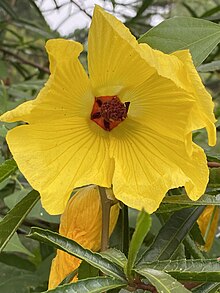Hibiscus heterophyllus
| Native rosella | |
|---|---|

| |
| Scientific classification | |
| Kingdom: | Plantae |
| Clade: | Tracheophytes |
| Clade: | Angiosperms |
| Clade: | Eudicots |
| Clade: | Rosids |
| Order: | Malvales |
| Family: | Malvaceae |
| Genus: | Hibiscus |
| Species: | H. heterophyllus |
| Binomial name | |
| Hibiscus heterophyllus | |
Hibiscus heterophyllus, commonly known as native rosella or toilet paper bush,[2] is a flowering plant in the family Malvaceae. It a shrub or small tree with white, pale pink or yellow flowers with a dark red centre and grows in New South Wales and Queensland.
Description
Hibiscus heterophyllus is a shrub or small tree with more or less smooth, prickly stems. The lower leaves are egg-shaped or with 3-5 lobes, upper leaves are narrowly oval shaped to narrowly lance shaped and 5–18 cm (2.0–7.1 in) long. The flowers are borne singly in leaf axils, calyx lobes lance-shaped, 20–35 mm (0.79–1.38 in) long with a dense covering of rusty-coloured star shaped, short, matted hairs. The flower corolla 5–7 cm (2.0–2.8 in) long, pale pink, white or yellow with a dark red centre. The fruit is 20 mm (0.79 in) long and covered with straw-coloured short, soft, upright hairs. Flowering occurs from spring to summer.[2][3]
Taxonomy and naming
Hibiscus heterophyllus was first formally described in 1805 by Étienne Pierre Ventenat and the description was published in Jardin de la Malmaison.[4][5] The specific epithet (heterophyllus) means "different" and "leaved" with reference to having varying shaped leaves.[3][6] Dtharang-gange is recorded as an Aboriginal name for the plant, from New South Wales.[7]
Distribution and habitat
This species is usually found in open forest, rainforest or nearby, from north-east Queensland to the south coast of New South Wales.[2]
References
- ^ "Hibiscus heterophyllus". Australian Plant Census. Retrieved 4 January 2021.
- ^ a b c Mitchell, A.S; Norris, E.H. "Hibiscus heterophyllus". PlantNET-NSW flora online. Royal Botanic Gardens Sydney. Retrieved 4 January 2021.
- ^ a b "Hibiscus heterophyllus". Australian Native Plant Society (Australia). Retrieved 7 January 2021.
- ^ "Hibiscus heterophyllus". Australian Plant Name Index. Retrieved 7 January 2021.
- ^ Ventenat, E. P (1805). Jardin de la Malmaison (2 ed.). Paris. p. 103.
- ^ Sharr, Francis Aubi; George, Alex (2019). Western Australian Plant Names and Their Meanings (3rd ed.). Kardinya, WA: Four Gables Press. p. 327. ISBN 9780958034180.
- ^ "Hibiscus heterophyllus | Purdue University Famine Foods".
- Fruit
- Flower buds



